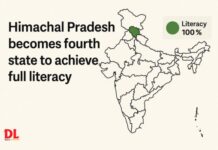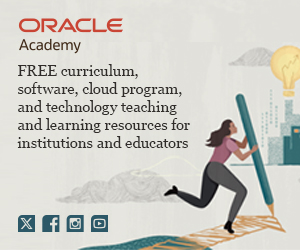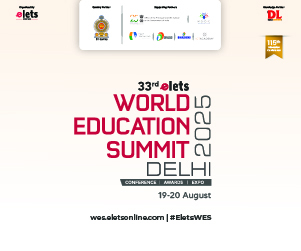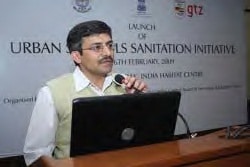Pondering over the quality of students who apply for technical education, it is worth attention that the aspiring young people who apply in institutions such as IIT show that at least 10-15 percent of these applicants are comparable to the students at major public universities in the US India VS world
Often heard government views, including views of Shri Kapil Sibal, Human Resource Development Minister, resonate of the great potential the India encompasses. It has been estimated that not far in the future, India will have a population ration where majority will be in segment of youth earners/ workers with minority remaining as dependent population, while most of the developed nations are to see a skew whereby majority of their respective populations will fall in category of dependent inhabitants. In such a scenario, India will hold the prospective workforce not only for itself but nations across the world. Foreseeing such a need, it becomes all the more important for us as a nation to have a skilled workforce which is not only trained but is recongnised or certified too, in order to deliver quality services.
populations will fall in category of dependent inhabitants. In such a scenario, India will hold the prospective workforce not only for itself but nations across the world. Foreseeing such a need, it becomes all the more important for us as a nation to have a skilled workforce which is not only trained but is recongnised or certified too, in order to deliver quality services.
Pondering over the quality of students who apply for technical education, it is worth attention that the aspiring young people who apply in institutions such as IIT show that ‘at least 10-15 percent of those applicants are of IIT quality and comparable to the students at major public universities in the U.S.’ At the same time, India as a nation has to still catch up with other countries. For instance, ‘A comparison between India and China in this regard shows that China has developed the technical education sector much more rapidly than India. China has produced more than 5,000 Ph.D. holders per year compared to India’s 1,000. China has also successfully implemented the concept of scalability as it currently has fifteen IITs (eight of which have only recently started), though it is still not clear how the newer IITs will be staffed with qualified faculty as in the existing IITs.’
Open Universities and Skill Development
 Open universities offer skill development and vocational education programmes, as a part of higher education sector, unlike other mainstream higher education universities. These courses are additional course which are not offered by the latter, especially in area of skill development. The open universities provide flexibility, anywhere-anytime access to education.
Open universities offer skill development and vocational education programmes, as a part of higher education sector, unlike other mainstream higher education universities. These courses are additional course which are not offered by the latter, especially in area of skill development. The open universities provide flexibility, anywhere-anytime access to education.
For instance, Indira Gandhi National Open University (IGNOU), the largest Open University offering distance learning programmes collaboration with Srei Sahaj e Village Limited, a part of Srei Infrastructure Finance Limited has come up with a cost effective skill development vocational programme, for Indian rural inhabitants. This has been channelised through over 29,000 Common Service Centres (CSCs) in states of West Bengal, Assam, Bihar, UP, Orissa and Tamil Nadu. This programme involves the learning strategy known as ‘Education That Works Learning System’ (ETWLS) that revolves around self regulated computational system and whereby, the skill assessment is done online.
SKILL DEVELOPMENT AT SCHOOLS
When it comes to skill education and vocational training, there is a noticeably high demand for skilled workers in the industry. The demand is met by supply of untrained/ non certifi ed labour, mainly consisting of illiterate youth/ children or the drop-outs. There have been lots of efforts made by the government in order to introduce vocational training in form of Industrial Training Institutes, etc, and other training centres of varying capacity across fi elds at higher education level, but there is hardly any initiative at K12 level for introduction of the same. The attitude towards training in areas away from the mainstream is not very positive in Indian context, especially for those who want to pursue and/ are in a position to pursue higher education. It is considered as the last or perhaps no option at all. For those students, however, who drop-out of school or are interested in becoming a part of the work force at an early age, vocational training and skill development are of utmost importance. Certifi cation in such cases, if provided, can help youth to attain good salaried jobs and earn a decent living. Without any kind of recognition, even if one is skilled, the person usually ends up having abrupt employment pattern or being unemployed off-and-on. The All India Council for Vocational Education under MHRD is responsible for planning, guiding and coordinating the programmes at national level for vocational education and training, mostly for the grade 10th pass students, besides the State Councils for Vocational Education at respective State Levels. A major question that rises is that of a ‘choice’.
Is it only the government school children who need to be ready for introduction of any skills or vocational training, because we observe a large drop-out from government schools? Shouldn’t there also be an effort to train students from public and private school as well so that, if there is a choice, the young people can join the workforce directly after secondary or senior secondary level? Offcourse, there is a need! However, still a greater need is that of bringing an attitude change in the society towards such training or learning. There is a need to introduce for our Indian audience the importance of the non formal education, which is taken as synonymous with the skill development and vocational training education, in a manner so that it is considered as an important a supplement to higher education, and not completely discarded as a left-over for those who cannot do anything else, with formal education.
Rita Kaul, Principal from The Millennium School, refl ects upon importance of non formal education or technical education, “At the Millennium School, besides academics, we anyway equip our students with a variety of life skills which will help them become productive citizens. It is an essential part of the cutting edge learning system called the Millennium Learning System adopted by us.” Similarly, SC Arora, Vice Chairman, Lotus Valley International School, mentioned that there is a need to make students adept with non-formal education or skill education and vocational training that can enable them to get a job immediately after school, more so students from that strata of the society who do not wish to pursue higher education.
He added that presently, most school students are not equipped with such skills that make them fi t for industrial based jobs. About inclusion of skill development in course and curriculum prescribed by CBSE, he opined that “Some subjects are there that cater to skill education and vocational training, but it is not adequate and most of the school do not go for this options.” We have in our school system some major drawbacks in form of hindrances such as absence of teachers, issues of quality and standardisation. Often technology is sought as a major tool to overcome these and add value to the in-use education system.
On similar lines, Rita Kaul, adds in support of role of technology for skill development and vocational training, “India has a fast-growing Service based industry. So there is defi nitely a huge role of IT based education if we want to dominate globally since it will help both in terms of increasing reach as well as enhancing quality.” ICT presents a more unique way of making learning interesting and existing, especially in reference to use of multi-media. With a similar opinion about role of ICT, SC Arora mentioned that for imparting any type of education ICT can be used in form of audio- video aids, which makes learning and grasping of a concept easier for students.
PRIVATE INITIATIVES AND SKILLDEVELOPMENT PROGRAMMES
Skilled labour force is not only a demand of the industry but also a concern. In order to share the effort of creating a trained skilled force many private companies have started collaborative programmes to offer livelihood, especially to rural youth. One of such initiatives
is the Larsen and Toubro Ltd, ECC division’s initiative in partnership with MoRD, Government of India, where the former supports the latter for execution of Demand Driven Skill Developmentany kind of recognition, even if one is skilled, the person usually ends up aving abrupt employment pattern or being unemployed off-and-on. The All India Council for Vocational Education under MHRD is responsible for planning, guiding and coordinating the
programmes at national level for vocational education and training, mostly for the grade 10th pass students, besides the State Councils for Vocational Education at respective State Levels. A major question that rises is that of a ‘choice’. Is it only the government school children who need to be ready for introduction of any skills or vocational training, because we observe a large drop-out from government schools? Shouldn’t there also be an effort to train students from public and private school as well so that, if there is a choice, the young people can join the workforce directly after secondary or senior secondary level? Offcourse, there is a need! However, still a greater need is that of bringing an attitude change in the society towards such training or learning. There is a need to introduce for our Indian audience the importance of the non formal education, which is taken as synonymous with the skill development and vocational training education, in a manner so that it is considered as an important a supplement to higher education, and not completely discarded as a left-over for those who cannot do anything else, with formal education.
Rita Kaul, Principal from The Millennium School, refl ects upon importance of non formal education or technical education, “At the Millennium School, besides academics, we anyway equip our students with a variety of life skills which will help them become productive citizens. It is an essential part of the cutting edge learning system called the Millennium Learning System adopted by us.” Similarly, SC Arora, Vice Chairman, Lotus Valley International School, mentioned that there is a need to make students adept with non-formal education or skill education and vocational training that can enable them to get a job immediately after school, more so students from that strata of the society who do not wish to pursue higher education. He added that presently, most school students are not equipped with such skills that make them fi t for industrial based jobs.
About inclusion of skill development in course and curriculum prescribed by CBSE, he opined that “Some subjects are there that cater to skill education and vocational training, but it is not adequate and most of the school do not go for this options.” We have in our school system some major drawbacks in form of hindrances such as absence of teachers, issues of quality and standardisation. Often technology is sought as a major tool to overcome these and add value to the in-use education system. On similar lines, Rita Kaul, adds in support of role of technology for skill development and vocational training, “India has a fast-growing Service based industry. So there is defi nitely a huge role of IT based education if we want to dominate globally since it will help both in terms of increasing reach as well as enhancing quality.” ICT presents a more unique way of making learning interesting and existing, especially in reference to use of multi-media. With a similar opinion about role of ICT, SC Arora mentioned that for imparting any type of education ICT can be used in form of audio- video aids, which makes learning and grasping of a concept easier for students.
PRIVATE INITIATIVES AND SKILL DEVELOPMENT PROGRAMMES
Skilled labour force is not only a demand of the industry but also a concern. In order to share the effort of creating a trained skilled force many private companies have started collaborative programmes to offer livelihood, especially to rural youth. One of such initiatives is the Larsen and Toubro Ltd, ECC division’s initiative in partnership with MoRD, Government of India, where the former supports the latter for execution of Demand Driven Skill Development Programme. Under this programme the company offers training to rural youth (BPL) in area of construction. The initiative costs around INR 470 million, out of which MoRD is responsible for 30% of the funds and remaining 70% is being taken care of by L&T, for training and infrastructure facilities.
SHOULD SKILLS AND MAINSTREAM HIGHER EDUCATION MERGE?
Some opine that tertiary education and /skill development and vocational training should be a part of the mainstream higher education system while others opine the opposite. For instance, Navyug Mohnot, CEO, QAI, “Skill development and vocational training should be constituted as a separate entity, more so in a country like India. This will broad-base the provision of skill development linked to the investment cost of education. Most western countries have a developed framework consisting of sector specifi c Skill Development Councils and Guilds that track industry manpower statistics, track quality and provide certifi cations of skill sets acquired. Higher Education Institutions (HEIs) do not typically understand the requirements of training needed for skill based jobs, as they specialise in grooming students for knowledge based jobs. However, HEI’s will gain by leveraging their brand, academic and physical infrastructure to provide private/corporate trainers a platform to disburse the skill development of the targeted manpower.” Participation of the private player facilitates not only infrastructural and monetary benefi ts to various programmes that they support, but also provides a platform for the youth in training to get hands on experience with the industry.
NATIONAL SKILL DEVELOPMENT MISSION IN INDIA
The 11th Five Year Plan aims to increase the present skill development capacity of 3.1 million per year to 15 million annually. India targets to develop manpower of 500 million skilled workers by 2022. The aim of the mission is to increase employability, meeting the supply demand balance, making employees adept with knowledge of technology and skills, improving livelihoods of people, and making skill development an attractive proposition for investment. The National Skill Development Mission is inclusive in nature and is to minimise disparities of gender, urban-rural, and employment in organised and unorganised sectors.
The objectives of the National policy on Skill Development include – creating opportunities to earn living, especially for disadvantaged groups, promoting participation of stakeholders from private sector in developing a workforce, creating a mechanism that caters to diverse needs of stakeholders/ industry and so on. Its coverage is to encompass development of institution-based skill development including ITIs/ITCs/vocational schools/technical schools/ polytechnics/ professional colleges, e-learning, webbased learning and distance learning and so on. The initiative promotes quality skill education to provide with skilled supply of labour to the dynamic, changing and increasing industrial demands. Under the same umbrella, effort are to be taken to create a framework of National Vocational Qualifi cation Framework (NVQF) in order to provide quality, fl exible, continuous, lifelong learning knowledge to the seekers of skill education. The initiative is to proceed with states becoming the key actors.
WHAT IS REQUIRED?
From the above note, it can be gatheredthat at present what we need to uplift the
value of skill development and vocational training in the country is
• Provide with trained instructor
• Provide with certifi cation and standardisation of courses available in the sector
• Have independent accreditation systems
• Include industry for facilitating various programmes in fi eld of skill training, and
• Bringing about change in the mindset of people about the fi eld, so that it can be regarded as more than ‘just the last option’










 Across the seas, in a conference room students of Bal Bharti Public School, Dwarka and students of Westhoughton School, Bolton, UK sat talking to each other as if they were in the same room. This was made possible by the Face to Faith Programme of Tony Blair Faith Foundation which aims to offer an authentic and meaningful environment in which students can develop key 21st century skills such as collaboration, communication, critical thinking and problem-solving. It also aims to improve young people's cultural/religious literacy, which is a vital skill in an increasingly complex, global society. Eyes glued to the plasma screen television and speaking to their peers at Westhought students were eloquent, honest and curious – which is a great starting point for any successful Video Conference. They had obviously really taken in the messages about communicating honestly in a respectful way.
Across the seas, in a conference room students of Bal Bharti Public School, Dwarka and students of Westhoughton School, Bolton, UK sat talking to each other as if they were in the same room. This was made possible by the Face to Faith Programme of Tony Blair Faith Foundation which aims to offer an authentic and meaningful environment in which students can develop key 21st century skills such as collaboration, communication, critical thinking and problem-solving. It also aims to improve young people's cultural/religious literacy, which is a vital skill in an increasingly complex, global society. Eyes glued to the plasma screen television and speaking to their peers at Westhought students were eloquent, honest and curious – which is a great starting point for any successful Video Conference. They had obviously really taken in the messages about communicating honestly in a respectful way.  Bangalore-based Srishti School of Art, Design and Technology has announced a joint programwith L’École de Design, Nantes Atlantique, a premier design school in France, to offer
Bangalore-based Srishti School of Art, Design and Technology has announced a joint programwith L’École de Design, Nantes Atlantique, a premier design school in France, to offer
 Institute of Technology (IIT)-Madras. Regarding the pressure that several students in CBSE schools are undergoing due to the Continuous and Comprehensive Evaluation (CCE), the chairman described that in order to combat the pressured caused on the students due to homework and projects, CBSE is encouraging schools to indulge in group projects and activities. The occasion also marked the launch of online and offl ine content in physics and chemistry by CBSE, which had been an initiative of Kuruvila Jacob, involving the collaborations of several academicians, research scholars, teachers as well as web designers.
Institute of Technology (IIT)-Madras. Regarding the pressure that several students in CBSE schools are undergoing due to the Continuous and Comprehensive Evaluation (CCE), the chairman described that in order to combat the pressured caused on the students due to homework and projects, CBSE is encouraging schools to indulge in group projects and activities. The occasion also marked the launch of online and offl ine content in physics and chemistry by CBSE, which had been an initiative of Kuruvila Jacob, involving the collaborations of several academicians, research scholars, teachers as well as web designers. A recent report by UNESCO Institute for Statistics (UIS) indicates a clear case of gender disparity in primary and secondary education across the world.
A recent report by UNESCO Institute for Statistics (UIS) indicates a clear case of gender disparity in primary and secondary education across the world. Book: The Ace of Soft Skills: Attitude, Communication and Etiquette for Success
Book: The Ace of Soft Skills: Attitude, Communication and Etiquette for Success Technology is playing a vital role in modernising education systems. Among other things, interactive whiteboards (IWBs) and audiovisual equipment are emerging as powerful tools in modern teaching.
Technology is playing a vital role in modernising education systems. Among other things, interactive whiteboards (IWBs) and audiovisual equipment are emerging as powerful tools in modern teaching. 
 providers. The government and private players are using this opportunity to provide relevant skills training to the population. Public – Private Partnerships are crucial to these developments,
providers. The government and private players are using this opportunity to provide relevant skills training to the population. Public – Private Partnerships are crucial to these developments,
 A Middle East-settled non-resident Indian industrialist, B R Shetty, recently announced his plans regarding opening of an Ayurveda medical college at the upcoming Herbal City in Abu Dhabi in the UAE in collaboration with Santhigiri Ashram in Kerala. He mentioned the same while addressing a gathering at a one-day conference on ‘Health and Research in The Middle East Asian Countries’, organised as part of the Parnasala Dedication Celebrations at Santhigiri Ashram. Santhigiri Healthcare Division is running a chain of Ayurveda hospitals and panchakarma centres all over India besides two medical colleges, one for Ayurveda and the other for siddha in Kerela
A Middle East-settled non-resident Indian industrialist, B R Shetty, recently announced his plans regarding opening of an Ayurveda medical college at the upcoming Herbal City in Abu Dhabi in the UAE in collaboration with Santhigiri Ashram in Kerala. He mentioned the same while addressing a gathering at a one-day conference on ‘Health and Research in The Middle East Asian Countries’, organised as part of the Parnasala Dedication Celebrations at Santhigiri Ashram. Santhigiri Healthcare Division is running a chain of Ayurveda hospitals and panchakarma centres all over India besides two medical colleges, one for Ayurveda and the other for siddha in Kerela Chancellor Eric D Fingerhut, from Ohio Board of Regents, announced the launch of OhioLearns! Gateway, a new initiative called for by Gov. Ted Strickland and the Ohio General Assembly. It would give all Ohio high school students access to online courses. This initiative is an addition to the existing OhioLearns! program, which has provided higher education distance learning courses and degree programs for public and private colleges and universities for more than 10 years. The students can avail navigation of the online course catalog and select from 40 approved courses, linking them to a variety of course providers and web-based courses. The courses will assist school districts across Ohio to differentiate educational offerings and meet the various needs of their students.
Chancellor Eric D Fingerhut, from Ohio Board of Regents, announced the launch of OhioLearns! Gateway, a new initiative called for by Gov. Ted Strickland and the Ohio General Assembly. It would give all Ohio high school students access to online courses. This initiative is an addition to the existing OhioLearns! program, which has provided higher education distance learning courses and degree programs for public and private colleges and universities for more than 10 years. The students can avail navigation of the online course catalog and select from 40 approved courses, linking them to a variety of course providers and web-based courses. The courses will assist school districts across Ohio to differentiate educational offerings and meet the various needs of their students. Cisco wired and wireless networking are to be standardised by the Department of Early Education and Child Development (DEECD), as the foundation for 21st-century teaching and learning in up to 1,000 primary and secondary schools across Victoria. This education-grade network will support future demand from one-to-one computing, mobility for flexible learning spaces, high-definition video, digital content and the Ultranet. DEECD’s innovative use of Cisco networking technology in schools will help create media-rich and highly engaging online curricula centered around video and collaboration, automate administrative processes, safeguard important school resources, and enhance the learning process in countless other ways.
Cisco wired and wireless networking are to be standardised by the Department of Early Education and Child Development (DEECD), as the foundation for 21st-century teaching and learning in up to 1,000 primary and secondary schools across Victoria. This education-grade network will support future demand from one-to-one computing, mobility for flexible learning spaces, high-definition video, digital content and the Ultranet. DEECD’s innovative use of Cisco networking technology in schools will help create media-rich and highly engaging online curricula centered around video and collaboration, automate administrative processes, safeguard important school resources, and enhance the learning process in countless other ways. Dr Mugheer Khamis Al Khaili, Director General of Abu Dhabi Education Council (ADEC), recently announced the launch of the New School Model (NSM). Dr Al Khaili explained that the new school model is to help in establishing a better education system and is to focus on overall development of the students, teachers, environment and community at large.
Dr Mugheer Khamis Al Khaili, Director General of Abu Dhabi Education Council (ADEC), recently announced the launch of the New School Model (NSM). Dr Al Khaili explained that the new school model is to help in establishing a better education system and is to focus on overall development of the students, teachers, environment and community at large. Recently, Swedish King Carl XVI Gustaf, conferred the Stockholm Water Prize on US scientist Rita R Colwell for her pioneering research on prevention of waterborne diseases. Colwell, a scientist with the University of Maryland and John Hopkins University in Stockholm, has made outstanding contributions to control the spread of cholera which affects some five million people worldwide and causes deaths to an estimated 120,000 people annually. She was joined by 17 previous Stockholm Water Prize laureates and hundreds of water experts at the City Hall of Stockholm.
Recently, Swedish King Carl XVI Gustaf, conferred the Stockholm Water Prize on US scientist Rita R Colwell for her pioneering research on prevention of waterborne diseases. Colwell, a scientist with the University of Maryland and John Hopkins University in Stockholm, has made outstanding contributions to control the spread of cholera which affects some five million people worldwide and causes deaths to an estimated 120,000 people annually. She was joined by 17 previous Stockholm Water Prize laureates and hundreds of water experts at the City Hall of Stockholm. With idea of diversifying into educational space, the Spice Group plans to set up a global university at Modipur in Rampur district of Uttar Pradesh by 2012. Recently, Group Chairman BK Modi described that the university is to support and propagate “holistic education”. The total cost of the project is estimated to be around `1,000 crore and the university is to be completed by 2012. To be built on nearly 100 acres at the site of the now defunct Modi Xerox factory, the university will be a part of S Foundation. The group is also planning to set up a Business Process Outsourcing (BPO) unit in Rampur, which will start its operations in the next three months.
With idea of diversifying into educational space, the Spice Group plans to set up a global university at Modipur in Rampur district of Uttar Pradesh by 2012. Recently, Group Chairman BK Modi described that the university is to support and propagate “holistic education”. The total cost of the project is estimated to be around `1,000 crore and the university is to be completed by 2012. To be built on nearly 100 acres at the site of the now defunct Modi Xerox factory, the university will be a part of S Foundation. The group is also planning to set up a Business Process Outsourcing (BPO) unit in Rampur, which will start its operations in the next three months. NIIT, leading Global Talent Development Corporation and Asia’s largest IT trainer, now forays into Afghanistan. The company has entered into a standard education Agreement with ARIA Institute of higher education, one of the top education institutes in the country, to develop an employable talent pool of IT professionals in Afghanistan. Under this standard education agreement, NIIT will offer cutting edge programs in software engineering and networking. NIIT will also offer career programs of six months to two years duration, a host of modular programs such as office productivity tools, hardware and networking programs, creative publishing and other high end technology programs to enhance employability for youth.
NIIT, leading Global Talent Development Corporation and Asia’s largest IT trainer, now forays into Afghanistan. The company has entered into a standard education Agreement with ARIA Institute of higher education, one of the top education institutes in the country, to develop an employable talent pool of IT professionals in Afghanistan. Under this standard education agreement, NIIT will offer cutting edge programs in software engineering and networking. NIIT will also offer career programs of six months to two years duration, a host of modular programs such as office productivity tools, hardware and networking programs, creative publishing and other high end technology programs to enhance employability for youth. Houghton Mifflin Harcourt, the publishing giant is to make a $400 million investment to back up the company’s increasing emphasis on putting more technology into classrooms. The announcement regarding the same was made on September 13, 2010 and it was mentioned alongside that the investment includes $100 million in incubator money for technology supporting student achievement. The Boston-based company also plans to invest $300 million over the next three years developing its own technology, such as a pilot algebra application for the Apple iPad currently being tested by 400 California students.
Houghton Mifflin Harcourt, the publishing giant is to make a $400 million investment to back up the company’s increasing emphasis on putting more technology into classrooms. The announcement regarding the same was made on September 13, 2010 and it was mentioned alongside that the investment includes $100 million in incubator money for technology supporting student achievement. The Boston-based company also plans to invest $300 million over the next three years developing its own technology, such as a pilot algebra application for the Apple iPad currently being tested by 400 California students. Sequoia Capital and Song Advisors announced that they have invested $ 15mn in K12 Techno Services Pvt. Ltd. K12 manages over 60 schools run by 15 different trusts under the Gowtham Model School and Orchids – the International school brand. It offers a whole gamut of specialized education support services to enhance the quality of learning and teaching. Sequoia Capital’s global experience and local expertise will help fuel K12’s expansion plans. With this investment, KP Balaraj, Managing Director, Sequoia Capital and Ravishankar GV, Principal, Sequoia Capital and Vishal Vasishth of SONG have joined the board of K12. Sequoia Capital’s
Sequoia Capital and Song Advisors announced that they have invested $ 15mn in K12 Techno Services Pvt. Ltd. K12 manages over 60 schools run by 15 different trusts under the Gowtham Model School and Orchids – the International school brand. It offers a whole gamut of specialized education support services to enhance the quality of learning and teaching. Sequoia Capital’s global experience and local expertise will help fuel K12’s expansion plans. With this investment, KP Balaraj, Managing Director, Sequoia Capital and Ravishankar GV, Principal, Sequoia Capital and Vishal Vasishth of SONG have joined the board of K12. Sequoia Capital’s specially designed training programme in online advertising which will be certifi ed by Google. The training programme in online advertising has been designed and customized to equip the Indian advertising and marketing professional with better understanding of Google’s global advertising programme Google ‘AdWords’. The programme content and module outline has been designed by experts from Google and will cover all aspects of search engine marketing, measuring and optimising online campaigns
specially designed training programme in online advertising which will be certifi ed by Google. The training programme in online advertising has been designed and customized to equip the Indian advertising and marketing professional with better understanding of Google’s global advertising programme Google ‘AdWords’. The programme content and module outline has been designed by experts from Google and will cover all aspects of search engine marketing, measuring and optimising online campaigns Ravinder Goyal
Ravinder Goyal








